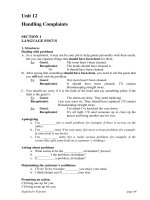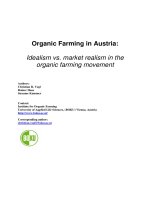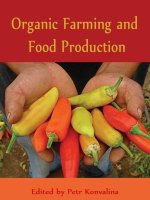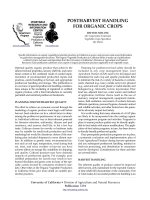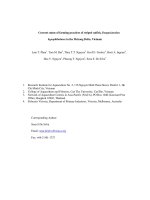Organic Farming Practices: Postharvest Handling
Bạn đang xem bản rút gọn của tài liệu. Xem và tải ngay bản đầy đủ của tài liệu tại đây (39.42 KB, 10 trang )
University of California Vegetable Research and Information Center
Page 1
Organic Farming Practices: Postharvest Handling
Optimal quality organic produce that combines the desired textural properties, sensory shelf-
life, and nutritional content results from the careful implementation of recommended production
inputs and practices, careful handling at harvest, and appropriate postharvest handling and
storage. This section will focus on an overview of general postharvest handling considerations
unique to the marketing of registered or certified organic produce. An introduction to current
permitted and restricted postharvest treatments will be presented.
Planning for Postharvest Quality
Achieving an economically rewarding enterprise via the marketing of organic produce must
begin well before harvest. Seed selection can be a critical decision factor in determining the
postharvest performance of any commodity. Individual cultivars have variable inherent potential
for firmness retention, uniformity, disease and pest resistance, and sensory shelf–life, to list a
few key traits. Cultivars chosen for novelty or heirloom traits may be suitable for small-scale
production and local marketing but would be disastrous if shipment to more distant markets was
attempted. In addition to genetic traits, environmental factors such as soil type, temperature,
wind during fruit set, frost, and rainy weather at harvest can have an adverse effect on storage
life, suitability for shipping, and quality. Cultural practices may have dramatic impacts on
postharvest quality. For example, poor seedbed preparation for carrots may result in sunburned
shoulders and green core with many of the specialty carrots favored by consumers at farmers
markets. For background on suitable production practices see Sections XXXX in this series.
Planning for postharvest food safety should be included in any crop management plan. Good
Agricultural Practices (GAP) need to be developed and formalized for each crop and specific
production field to minimize the risk of chemical (ex. heavy metals carryover), physical (ex.
sand and soil, wood, plastic or metal shards), and biological (ex. Salmonella, Listeria,
mycotoxins) hazards and contaminants. Prior land use, adjacent land use, water source and
method of application, fertilizer choice (such as the use of manure), compost management,
equipment maintenance, field sanitation, movement of workers between different operations,
personal hygiene, domestic animal and wildlife activities, and other factors have the potential to
adversely impact food safety.
It is worth noting that many elements of a GAP plan are likely to be incorporated into the
existing organic crop management program and activities. Programs in place to ensure produce
quality may be directly applicable to food safety with minor modifications. Applying food safety
programs, in turn, have been shown to directly benefit postharvest quality.
Once prerequisite production programs are in place, a systematic evaluation and
implementation plan of Good Agricultural Practices during harvest operations and any
subsequent postharvest handling, minimal or fresh-cut processing, and distribution to consumers
must be developed. Considerations for these activities are covered below.
University of California Vegetable Research and Information Center
Page 2
Harvest Handling
The inherent quality of produce cannot be improved after harvest, only maintained for the
expected window of time characteristic of the commodity. Part of successful postharvest
handling is knowing what this window of opportunity is under your specific conditions of
production, season, method of handling, and distance to market. Among the benefits of organic
production, it is often more common to harvest and market near or at peak ripeness than in many
conventional systems. However, organic production often includes more specialty varieties that
have reduced or even inherently poor shelf life and shipping traits. As a general approach, the
following practices can help to maintain quality:
1. Harvest during the coolest time of the day to maintain low product respiration.
2. Avoid unnecessary wounding, bruising, crushing, or damage from humans, equipment, or
harvest containers.
3. Shade harvested product in the field to keep it cool. Covering harvest bins or totes with a
reflective pad greatly reduces heat gain from the sun and reduces water loss and premature
senescence.
4. If possible, move product into a cold storage facility or postharvest cooling treatment as soon
as possible. For some commodities, such as berries, tender greens and leafy herbs, one hour
in the sun is too long.
5. Don’t compromise high quality product by intermingling damaged, decayed, or decay-prone
product in a bulk or packed unit.
6. Only use cleaned and, as necessary, sanitized packing or transport containers.
These operating principles are important in all operations but carry special importance for many
organic producers due to limited postharvest cooling opportunities.
Postharvest Storage
Temperature is the single most important tool to maintain postharvest quality. Other than
field cured or durable products, removing field heat as rapidly as possible is highly desirable.
Harvesting cuts off a vegetable from its source of water. However, it is still alive and will lose
water, and therefore turgor, due to respiration. Field heat can accelerate the rate of respiration
and therefore the rate of quality loss. Proper cooling protects quality and extends both the
sensory (taste) and nutritional shelf life of produce. The capacity to cool and store produce
creates greater market flexibility. There is a tendency by growers to underestimate the
refrigeration capacity needed for peak cooling demand. It is often critical to reach the desired
short-term storage or shipping pulp temperature rapidly to maintain the highest visual quality,
flavor, texture, and nutritional content of fresh produce. The most common cooling methods are:
1. Room cooling: An insulated room or mobile container equipped with refrigeration units.
Room cooling is slow compared with other options. Depending on the commodity, packing
unit, and stacking arrangement the product may cool too slowly to prevent water loss,
premature ripening, or decay.
2. Room cooling: An insulated room or mobile container equipped with refrigeration units.
Room cooling is slow compared with other options. Depending on the commodity, packing
unit, and stacking arrangement the product may cool too slowly to prevent water loss,
premature ripening, or decay.
University of California Vegetable Research and Information Center
Page 3
3. Forced-air cooling: Fans are used in conjunction with a cooling room to pull cool air through
packages of produce. Although the cooling rate depends on the air temperature and the rate
of airflow, this method is usually 75–90% faster than room cooling. Design considerations
for very small-scale to sophisticated large-scale units are available in DANR #21567.
4. Hydrocooling: Showering produce with chilled water is an efficient way to remove heat, and
can serve as a means of cleaning at the same time. Use of a disinfectant in the water is
essential and the some of the currently permitted products are discussed in the following
section. Hydrocooling is not appropriate for all produce. Waterproof containers or resistant
waxed-corrugated cartons are required. Currently waxed corrugated cartons have limited
recycling or secondary use outlets and reusable, collapsible plastic containers are gaining
popularity. A list of vegetables that are suitable for hydrocooling is available in DANR 3311
and 21567
5. Top or liquid icing: Icing is an effective method to cool tolerant commodities and is equally
adaptable to small or large-scale operations. Ice-tolerant vegetables are listed in DANR 3311
and 21567. Ensuring that the ice is free of chemical, physical, and biological hazards is
essential.
6. Vacuum cooling: Under vacuum, water within the plant evaporates and removes heat from
the tissues. This system works well for leafy crops, such as lettuce, spinach, and celery,
which have a high surface-to-volume ratio. Water may be sprayed on the produce prior to
placing it vacuum. As with hydrocooling, proper water disinfection is essential (See
Sanitation and Water Disinfection). The cost of the vacuum chamber system restricts its use
to larger operations.
The considerations and selection of appropriate cooling methods and appropriate storage
temperature and humidity conditions for a large diversity of vegetables are available in DANR
publications 3311 and 21567. In large cooling operations handling both conventional and organic
commodities, it is common to hydrocool (also water-spray vacuum cooling) organic produce at
the beginning of daily operation, after a full cleaning and complete water exchange. This practice
is intended to prevent carry-over or cross-contamination of organic produce with synthetic
pesticide or other prohibited residues. This will generally require at least overnight short-term
storage.
Other postharvest issues involving combined steps of unloading commodities from harvest
bins, washing, and precooling must also be evaluated for adherence to organic standards. Some
operators use flotation as a method of reducing damage at the point of grading and packing.
Entire bins are submerged in a tank of water treated with a chemical flotation aide that allows the
picked product to be gently removed and separated from the container. Lignin sulfonates are
allowed in certified organic handling as a flotation aid for water-based unloading of field bins or
other density separation applications.
Sanitation and Water Disinfection
Preventive food safety programs, proper sanitation of equipment and food contact surfaces,
and water disinfection should be integrated into every facet of postharvest handling. Food safety
and decay/spoilage control are concerns for produce handlers at all scales of production. E. coli
0157:H7, Salmonella, Shigella, Listeria, Cryptosporidium, Hepatitis, and Cyclospora are among
the disease-causing organisms that have been associated with fresh fruits and vegetables. There
University of California Vegetable Research and Information Center
Page 4
are several cases of food-borne illness traced to poor or unsanitary postharvest practices,
especially non-potable cooling water and ice.
For organic handlers, the nature and prior use of water is a special consideration. Postharvest
water cannot, at any time, contain prohibited substances dissolved in water. This responsibility
applies to the organic producer, handler, processor or retailer. Even incidental contamination
from a prohibited material would render product non-certified. Organic producers, packers, and
handlers are required to keep accurate and specific records of postharvest wash or rinse
treatments, identified by brand name and source. For a more complete discussion of postharvest
water disinfection see DANR 8003.
In brief, proper use of a disinfectant in postharvest wash and cooling water can help prevent
both postharvest diseases and food-borne illnesses. Since most municipal water supplies are
chlorinated and in recognition of the vital role of water disinfection, organic growers, shippers,
and processors may use chlorine within specified limits. All forms of chlorine (ex. liquid sodium
hypochlorite, granular calcium hypochlorite, and chlorine dioxide) are restricted materials as
defined by existing organic standards. The application must conform with Maximum Residual
Disinfectant Limit under the Safe Drinking Water Act, currently 4 mg/L (4 ppm) expressed as
Cl2. The California Certified Organic Farmers (CCOF) regulations have permitted this threshold
of 4 ppm residual chlorine, measured downstream of the product wash [ Due to food safety
concerns the CCOF has recent modified this threshold to permit 10 ppm residual chlorine
measured downstream of the wash step]. Growers certified by other agencies should check with
their certifying agent.
As a general practice, minimizing field soil on product, bins, totes, and pallets by pre-
washing will significantly reduce the disinfectant demand of the water and lower the total
required volume of antimicrobial agent. Pre-washing also removes plant exudates released from
harvest cuts or wounds that can rapidly react with oxidizers, such as hypochlorite and ozone,
requiring higher rates to maintain the target 4 to 10 ppm downstream activity.
For both organic and conventional operations, liquid sodium hypochlorite is the most
common form used. For optimum antimicrobial activity with a minimal concentration of applied
hypochlorite, the water pH must be adjusted to 6.5 to 7.5. At this pH range, the majority of the
chlorine is in the form of hypochlorous acid (HOCl) which delivers the highest rate of microbial
kill and minimizes the release of irritating and potential hazardous chlorine gas (Cl
2
). Chlorine
gas will exceed safe levels if the pH is too acid. Products used for pH adjustment must be from a
natural source such as citric acid, sodium bicarbonate or vinegar. Calcium hypochlorite, properly
dissolved, may provide benefits of reduced sodium injury to sensitive crops (ex. some apples
varieties) and limited evidence points towards extended shelf-life due to calcium uptake (ex.
tomatoes and bell peppers). Amounts of hypochlorite to add to clear, clean water for
disinfestations are the following:
University of California Vegetable Research and Information Center
Page 5
Upstream
Target ppm*
fl. oz/5 gal.
cups/50 gal
Sodium hypochlorite (a.i.5.25%) 25 .28 .25
50 .55 .50
75 .80 .75
100 1.10 1.00
Sodium hypochlorite (a.i.12.7%) 25 .06 .05
50 .12 .10
75 .17 .15
100 .23 .20
* Organic certification standards permit a maximum of 10 ppm residual chlorine downstream of
the product wash step. Each crop, water source and quality, water pH, and other factors will
influence the total upstream hypochlorite needed to maintain this target level. A general starting
point is 50 ppm for produce with low soil content or minimal tissue damage and cell
leakage(such as from harvest cuts) following harvest. Some products, such as spring mix, may
require higher initial upstream chlorination due to high amounts of organic compounds released
from harvest wound sites tying up available hypochlorous acid. This is best determined in
practice and on-site with appropriate monitoring equipment or kits, which include titration
methods in combination with oxidation-reduction potential (ORP) probes. Higher levels of
hypochlorite or other chlorinated products are permissible for equipment surface and crate or tote
cleaning provided treatment is followed by a thorough clean water rinse (See Cleaners and
Disinfectants).
Ozone is an attractive option for water disinfection and other postharvest applications.
Ozonation is a powerful oxidizing treatment and is effective against chlorine-resistant decay
microbes and food-borne pathogens, acting far faster than permissible chlorine concentrations.
This may be a distinct advantage for cooling or wash procedures with short contact times. Ozone
oxidative reactions create far fewer disinfection by-products (ex. trihalomethanes are a health
and environmental concern) as compared to chlorination. The decision to use ozonation rather
than chlorination in organic postharvest operations may be made despite higher capital and
operating costs in comparison with chlorine or other available methods.
Ozone must be generated on-site at the time of use and has a very low stability, as short as 20
minutes even in clear water. Clear water is essential for optimal performance and adequate
filtration of input or recirculating water is needed. Depending on scale and ozone generation
output, complete systems costs start at about $10,000. Small-scale units are available for a few
thousand dollars and are suitable for limited water-use and small batch applications. For
specifications and installation consult an experienced ozone service provider (See Resources
Directory).
Food-grade hydrogen peroxide (0.5 to 1%) and peroxyacetic acid are additional options. In
general, peroxyacetic acid (PAA) has good efficacy in water dump tanks and water flume
sanitation applications. PAA has very good performance, as compared to chlorine and ozone, in

